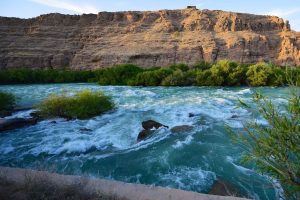On January 19, Afghanistan opened the gates of the Kamal Khan Dam, which sits astride the Helmand River in Nimroz province. Videos of water gushing out of the dam went viral on social media soon after and triggered jubilant celebrations in Iran’s Sistan-Baluchestan province. Iranians believed that the Helmand’s waters had been released and would reach Iran in a matter of hours.
Iran welcomed the decision of Taliban officials to release the waters of the Kamal Khan dam. Its deputy ambassador to Afghanistan, Hassan Mortazavi, said the water was released following talks between Iranian officials and a Taliban delegation led by interim Minister of Foreign Affairs Amir Khan Muttaqi during the latter’s visit to Tehran in January. The Iranian president’s special envoy for Afghanistan, Hassan Kazemi Qommi, even thanked Taliban authorities for “fulfilling their promise” of releasing the Helmand River’s dammed water.
However, Iran’s joy over the release of the river’s waters proved to be short-lived. It seems to have jumped the gun.
Afghanistan had indeed opened the gates of the Kamal Khan Dam — not to send the Helmand’s waters across the border to reach Iran but to irrigate agricultural land in areas surrounding the dam, the spokesman for the Ministry of Water and Power clarified.
Protests erupted in Iran soon after, and Afghan drivers and trucks entering Iran were pelted with stones.
A 1,300-km-long river that has its source in the Hindu Kush mountains to the west of Kabul, the Helmand River winds in a southwesterly direction and empties its waters in Lake Hamoun in Iran’s Sistan-Baluchestan province.
Construction of the Kamal Khan Dam began in 1996 but was put on hold due to the fighting in Afghanistan. Work on the project was resumed when Ashraf Ghani became Afghanistan’s president in 2014 and it was inaugurated in March 2021.
The transboundary Hamoun wetlands are fed by the Helmand River. But drought and poor water management is drying the area out and destroying the rich biodiversity it supports. Thousands of local fishermen have lost their livelihoods and are migrating out of the region. Sistan-Baluchestan, a Sunni-dominated province in predominantly Shia Iran, is a restive region and Tehran is worried that loss of livelihood and other related issues will fuel discontent and militancy.
Iran has strongly opposed Afghanistan’s damming of its transboundary rivers. It has accused Kabul of denying it of its water rights as a lower riparian country.
In 1973, Iran and Afghanistan signed a water-sharing accord on the Helmand River, under which Afghanistan would provide Iran with 22 cubic meters per second of water with an option to purchase an additional 4 cubic meters per second for “goodwill and brotherly relations.”
However, political turmoil in both countries prevented the treaty’s ratification and implementation.
Afghanistan maintains that for decades it allowed all its rivers to flow unimpeded to the lower riparian countries. As a result of the civil war and its ramshackle dam infrastructure, successive governments were not able to enforce its rights as an upper riparian country. It was only during Ghani’s presidency that Afghanistan began building dams like the Salma Dam across the Harirud River and the Kamal Khan Dam on the Helmand for water storage and increasing hydropower generation.
Iran tried to halt the building of these dams. In addition to pressuring the Ghani government, it used Taliban fighters to sabotage construction of the dams.
Since August 2021, when the Taliban came to power in Afghanistan, Iran is said to have held several rounds of talks with Taliban officials, the most recent being the one in January with Muttaqi.
During the Ghani presidency, Afghanistan hesitated to negotiate settlements to water disputes with neighboring Iran and Pakistan. Among the reasons for its reluctance was the fact that Afghanistan lacked hydrological data and technical expertise. With many Afghan scholars and experts having fled the country after the Taliban came to power, Afghanistan has even less expertise on water management issues today than it did in the past.
Yet Taliban officials have been talking to the Iranians on the water sharing issue. It is likely that they will use water to get Tehran to concede some of their demands. Topping their list of demands is, of course, the question of Iran extending the Taliban regime diplomatic recognition. Iran has ruled out recognizing the Taliban regime until it is inclusive.
It is unclear whether the two sides are considering retaining the provisions of the 1973 treaty, changing it, or junking it to finalize a new deal, Why Iranian officials claimed that a deal was reached is unclear too. Or were Taliban authorities sending out a trial balloon to see how locals would react if water was released to Iran?
What the recent protests and violence over the Helmand’s waters underscore is that water is a volatile issue between the two countries. Recent rains in the upper reaches of the Helmand River resulted in the dam filling up.
In a few months, the land through which the river runs, especially in the Sistan-Baluchestan province, will be dry and tempers will be running high. A swift settlement of the water-sharing issue will prevent violence in the two countries. Afghan refugees living in Iran are vulnerable targets in this regard.

































